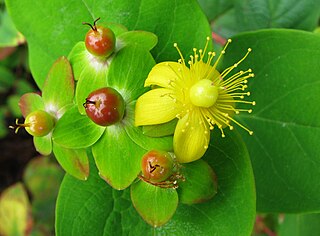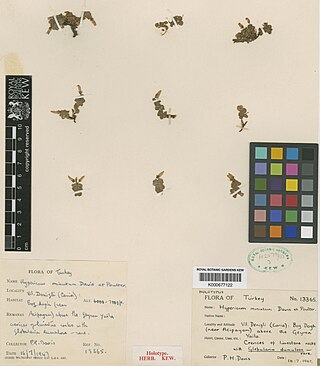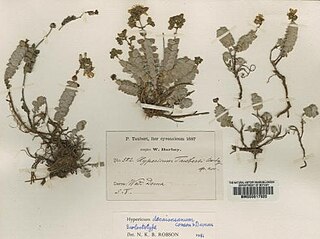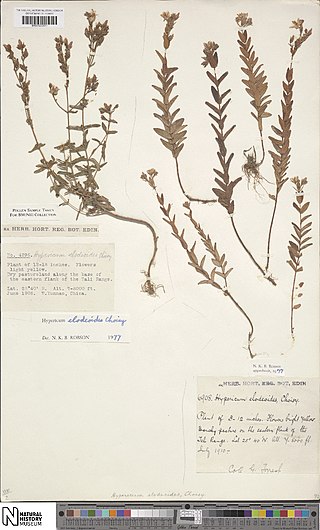Hypericum collinum is a flowering plant in the family Hypericaceae which is found in Mexico.

Hypericum bupleuroides is a species of perennial flowering plant in the St John's wort family, Hypericaceae. It grows 45–80 centimeters tall, and notably has perfoliate leaves that are fused at the stem. It has pyramid-shaped flower clusters of 1 to 25 flowers with yellow petals in a star-shaped arrangement. The species is found along the Black Sea coast near the Turkish–Georgian border. Hypericum bupleuroides has a small distribution and specific habitat requirements that make it vulnerable to environmental pressures.

Androsaemum, commonly called tutsan, is a section of flowering plants in the family Hypericaceae. It is made up of Hypericum androsaemum, H. foliosum, H. grandifolium, and H. hircinum, as well as the hybrid H. × inodorum. When it was first described, it was considered its own independent genus, but was later placed under Hypericum and demoted to a section. It is also the namesake of an "Androsaemum-group" of related taxa that includes several other sections of Old World species. The Latin name Androsaemum comes from a Greek work to describe plants with red sap, and literally means "blood-man".

Hypericum foliosum, the shining St John's wort, is a species of flowering plant in the family Hypericaceae. It is a bushy shrub endemic to the Portuguese Azores Islands with golden yellow petals and many stems. The species was described by William Aiton in 1789 and was later placed into section Androsaemum of the genus Hypericum by Norman Robson in 1984. It has a diverse essential oil profile made up mostly of monoterpene hydrocarbons, and significant concentrations of various medicinally useful phenols and carotenoids. Populations of the plant are small in number, but quick to colonize cleared areas like groves, landslide areas, and volcanic ash deposits. It is parasitized by fungus and by moth species, but is not considered endangered by the IUCN. H. foliosum is used in traditional medicine on the Azores for diuretic, hepatoprotective, and antihypertensive purposes. It also has in vitro antibiotic and antioxidizing capabilities.

Hypericum sect. Adenosepalum is one of 36 sections in the genus Hypericum. Its type species is Hypericum montanum.

Hypericum sechmenii, or Seçmen's St John's wort, is a rare species of flowering plant of the St John's wort family (Hypericaceae) that is found in the Eskişehir Province of central Turkey. It was first described in 2009 by Turkish botanists Atila Ocak and Onur Koyuncu, who named the species in honor of Özcan Seçmen, a fellow botanist. They assigned the species to the genus Hypericum, and Norman Robson later placed H. sechmenii into the section Adenosepalum.

Hypericum formosissimum is a species of flowering plant in the St John's wort family Hypericaceae. Found in the cracks of limestone rocks, it is a small perennial herb that grows in a pillow-like shape, has yellow flower petals, and blooms in the late summer. The plant is rare and has a limited habitat in Turkey, Armenia, and Azerbaijan. It is threatened by rock collapses, urbanization, and road construction; it is not protected by conservation efforts.

Hypericum heterophyllum is a flowering plant in the Hypericaceae family and is the only species in Hypericum sect. Heterophylla.

Hypericum minutum is a species of flowering plant in the St John's wort family Hypericaceae. It is a small perennial herb that grows in tufts. It has slender and brittle stems, flowers in clusters of one to three, yellow petals with black and amber glands, few stamens, and a seed capsule with narrow grooves. H. minutum is closely related to H. huber-morathii and H. sechmenii and resembles a smaller form of the latter plant. The plant is endemic to Turkey, and is found among limestone rocks in a limited region of southwestern Anatolia. Originally excluded from a comprehensive monograph of Hypericum, the species' placement within the genus is unclear. It has been placed in both section Adenosepalum and section Origanifolium.

Hypericum collenetteae is a species of flowering plant of the St. John's wort family (Hypericaceae) that is found in Saudi Arabia.

Hypericum coadunatum is a species of flowering plant of the St. John's wort family (Hypericaceae) that is found in the Canary Islands.
Hypericum psilophytum is a species of flowering plant of the St. John's wort family (Hypericaceae) that is found in Morocco and Algeria.
Hypericum scruglii is a species of flowering plant of the St. John's wort family (Hypericaceae) that is found in Sardinia.
Hypericum somaliense is a species of flowering plant of the St. John's wort family (Hypericaceae) that is found in Somalia.

Hypericum tomentosum is a species of flowering plant of the St. John's wort family (Hypericaceae) that is found in the western Mediterranean.

Hypericum decaisneanum is a species of flowering plant in the St John's wort family Hypericaceae. Named for French botanist Joseph Decaisne, it is a small perennial herb that grows mostly upright. It has thick, papery leaves and up to twenty flowers with bright yellow petals. Endemic to the Jebel al Akhdar province of Libya, H. decaisneanum is found in the cracks of limestone rocks on steep escarpments. It is a member of numerous plant communities and associations of chasmophytes, of which it is sometimes a key species. First described in 1899, the species was originally placed in section Taeniocarpium of the genus Hypericum, but conflicting relationships have meant it has been treated more recently as a member of section Adenosepalum.

Hypericum elodeoides, commonly called the Himalayan St. John's Wort, is a species of flowering plant of the St. John's wort family (Hypericaceae).
Hypericum monanthemum is a species of flowering plant of the St. John's wort family (Hypericaceae) which is native to the Himalayan mountains.
Hypericum iwatelittorale, originally styled Hypericum iwate-littorale, is a species of flowering plant in the family Hypericaceae. Named for its habitat in the coastal regions of the Iwate Prefecture in Japan, little is known about the ecology and conservation status of the plant. The species is a small perennial herb with five bright yellow petals on its up to thirty flowers. It has many stamens, and an array of pale and black glands on its leaves, sepals, and petals. Described in 1937 by Hideo Koidzumi, it has at times been considered a synonym of Hypericum pseudopetiolatum. However, it was affirmed to be a unique species in 2003 and was placed into the type section of Hypericum, with its similarities to H. tosaense being noted.














